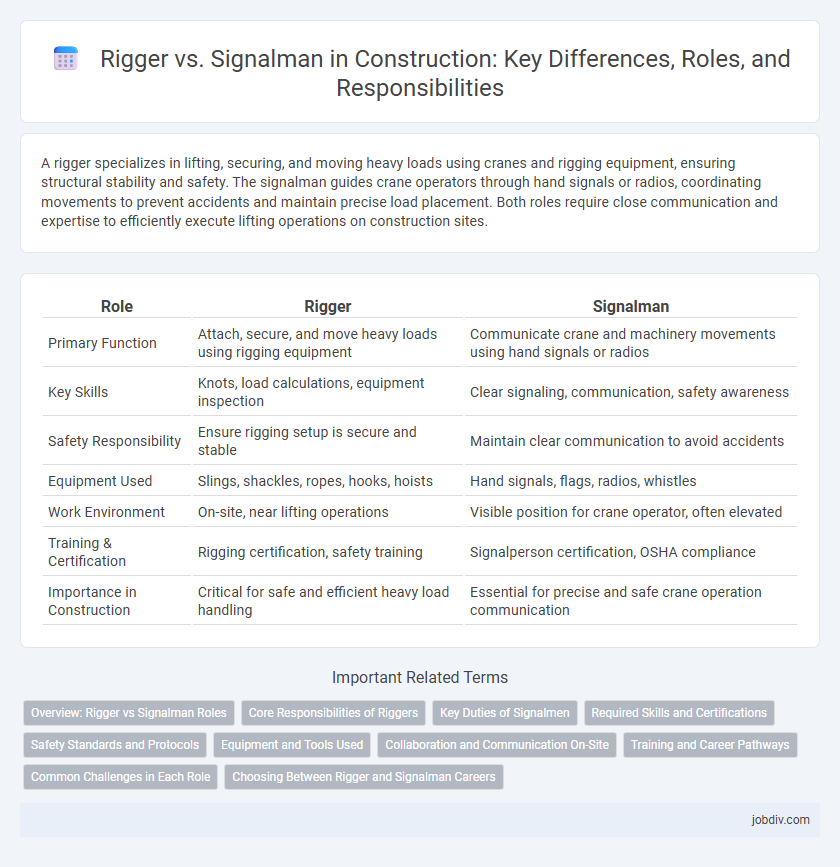A rigger specializes in lifting, securing, and moving heavy loads using cranes and rigging equipment, ensuring structural stability and safety. The signalman guides crane operators through hand signals or radios, coordinating movements to prevent accidents and maintain precise load placement. Both roles require close communication and expertise to efficiently execute lifting operations on construction sites.
Table of Comparison
| Role | Rigger | Signalman |
|---|---|---|
| Primary Function | Attach, secure, and move heavy loads using rigging equipment | Communicate crane and machinery movements using hand signals or radios |
| Key Skills | Knots, load calculations, equipment inspection | Clear signaling, communication, safety awareness |
| Safety Responsibility | Ensure rigging setup is secure and stable | Maintain clear communication to avoid accidents |
| Equipment Used | Slings, shackles, ropes, hooks, hoists | Hand signals, flags, radios, whistles |
| Work Environment | On-site, near lifting operations | Visible position for crane operator, often elevated |
| Training & Certification | Rigging certification, safety training | Signalperson certification, OSHA compliance |
| Importance in Construction | Critical for safe and efficient heavy load handling | Essential for precise and safe crane operation communication |
Overview: Rigger vs Signalman Roles
Riggers specialize in lifting operations, ensuring safe attachment, movement, and positioning of heavy loads using cranes or hoists. Signalmen, also called spotters, communicate crane movements through standardized hand signals or radios to guide riggers and operators precisely. Both roles collaborate closely to maintain safety and efficiency during complex construction lifting tasks.
Core Responsibilities of Riggers
Riggers are responsible for the safe lifting, moving, and positioning of heavy materials and equipment using cranes, hoists, and other rigging gear. They inspect rigging hardware such as slings and shackles, ensuring load capacities are met to prevent accidents on construction sites. Signalmen primarily direct crane operations, while riggers execute the physical tasks of securing loads and maintaining safety protocols during lifts.
Key Duties of Signalmen
Signalmen in construction are responsible for directing crane and heavy equipment operators to ensure safe and precise load movements. They use standardized hand signals and radio communication to coordinate lifting operations, minimizing risks on-site. Their key duties also include monitoring loads, assessing potential hazards, and ensuring compliance with safety regulations.
Required Skills and Certifications
Rigging specialists must possess expertise in load calculations, equipment inspection, and knot tying, alongside certifications such as OSHA Rigger and NCCCO Crane Operator credentials. Signalmen are required to master standardized hand signals, radio communication, and safety protocols, often holding certifications like NCCCO Signalperson or Specialized Signalperson certifications. Both roles demand comprehensive knowledge of OSHA regulations and adherence to ANSI standards to ensure workplace safety and effective crane operations.
Safety Standards and Protocols
Riggers and signalmen both play crucial roles in construction safety, with riggers responsible for securing loads and ensuring lifting equipment is properly used, while signalmen communicate clear, standardized hand signals to coordinate crane and hoist movements safely. Adhering to OSHA safety standards, riggers must inspect rigging gear for defects and confirm load stability before lifts, reducing the risk of accidents. Signalmen follow strict protocols for visibility and communication, using established signals to prevent miscommunication and enhance on-site safety during heavy lifting operations.
Equipment and Tools Used
Riggers primarily use hoisting equipment such as wire ropes, slings, shackles, and chain blocks to lift and secure heavy loads safely during construction projects. Signalmen rely on radios, flags, hand signals, and audible devices to communicate precise instructions to crane operators and other machinery handlers on site. Both roles require specialized tools to ensure load stability and effective coordination, critical for maintaining safety and efficiency in lifting operations.
Collaboration and Communication On-Site
Effective collaboration between riggers and signalmen is critical for safe and efficient crane operations on construction sites. Riggers ensure proper attachment of loads while signalmen provide precise visual or radio signals to crane operators, minimizing risks and enhancing workflow coordination. Clear, continuous communication protocols and mutual understanding of hand signals or radio codes are essential to prevent accidents and maintain site productivity.
Training and Career Pathways
Riggers undergo specialized training in lifting techniques, load calculations, and equipment safety to ensure precise handling of heavy materials, while signalmen receive instruction in hand signals, radio communication, and site coordination for directing crane operations. Career pathways for riggers often advance toward roles such as crane operators or lift supervisors, emphasizing technical expertise in rigging systems. Signalmen typically progress into positions like crane operators or site safety coordinators, with a strong focus on communication skills and operational oversight in construction projects.
Common Challenges in Each Role
Riggers often face challenges such as ensuring proper load securing, managing heavy equipment safely, and preventing accidents caused by miscommunication or equipment failure. Signalmen struggle with maintaining clear and precise communication signals to crane operators, interpreting hand signals accurately in noisy environments, and coordinating multiple movements simultaneously to avoid collisions. Both roles require rigorous attention to safety protocols and effective teamwork to minimize construction site hazards.
Choosing Between Rigger and Signalman Careers
Choosing between a rigger and signalman career depends on your strengths in physical coordination and communication skills; riggers specialize in assembling and moving heavy loads using cranes, requiring precise knowledge of load dynamics and safety protocols. Signalmen focus on directing crane operators through hand or radio signals, emphasizing clear visibility, situational awareness, and effective communication to ensure safe lifting operations. Both roles demand rigorous safety training and certification, but career paths diverge based on preference for hands-on technical rigging tasks versus critical communication and coordination responsibilities.
Rigger vs Signalman Infographic

 jobdiv.com
jobdiv.com